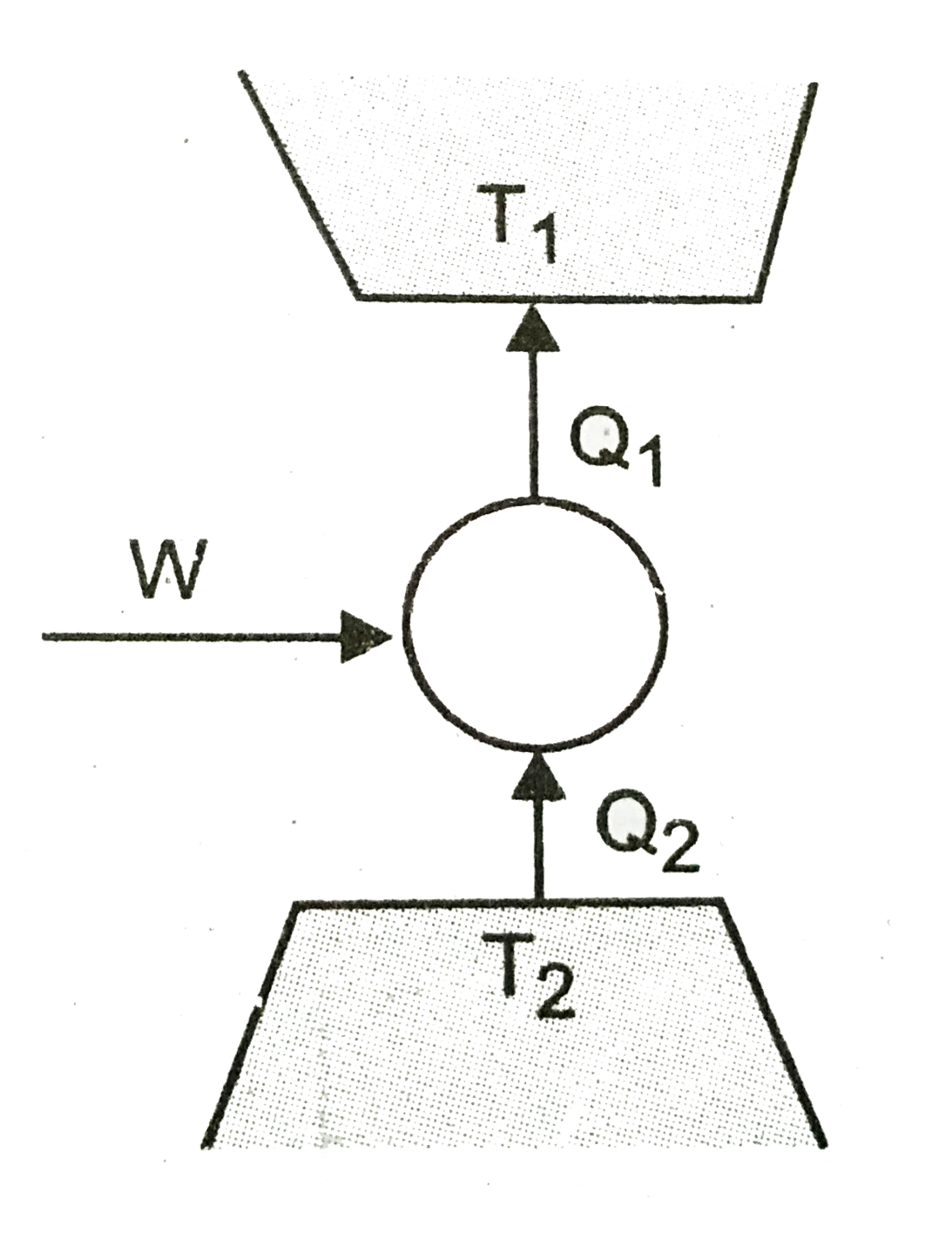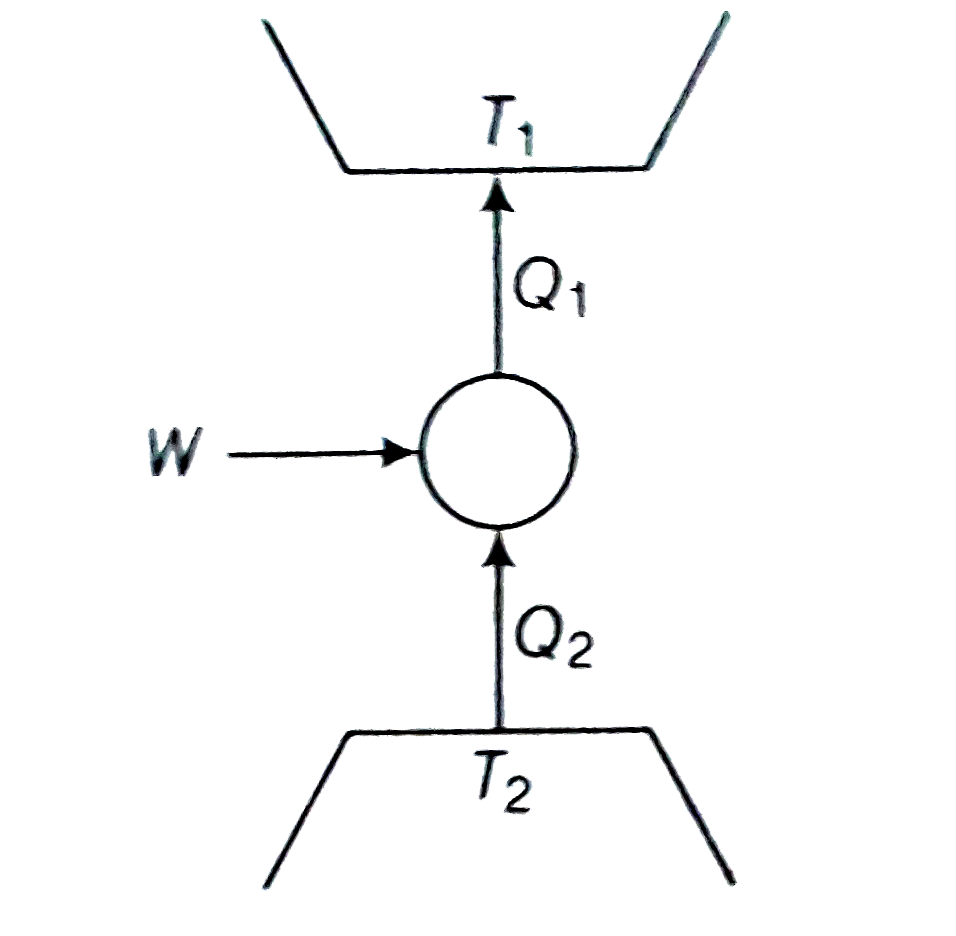Consider a heat engine as shown in (figure). Q1andQ2 are heat added to heat bath T1 and heat taken from T2 one cycle of engine. W is the mechanical work done on the engine.

If W>0, then possibillities are:
Q1>Q2>0
Q2>Q1>0
Q2<Q1<0
Q1<0,Q2>0
The correct Answer is:A, C
(figure). Represents the working of a refrigerator, wherein Q1=Q2+W
If W>0,Q1>0.
Both Q1 and Q2 are positive.
If Q2 is negative, Q1 is also negative (but less negative as W>0). ∴Q2<Q1<0
Choices (a) and (c ) are corrcet.
Topper's Solved these Questions
- THERMODYNAMICSBOOK - PRADEEPCHAPTER - THERMODYNAMICSEXERCISE - Interger Type questions
11 Videos
- THERMODYNAMICSBOOK - PRADEEPCHAPTER - THERMODYNAMICSEXERCISE - Assertion- Reason Type Questions
19 Videos
- THERMODYNAMICSBOOK - PRADEEPCHAPTER - THERMODYNAMICSEXERCISE - Multiple choice questions (NCERT)
10 Videos
- SYSTEMS OF PARTICLES AND ROTATIONAL MOTIONBOOK - PRADEEPCHAPTER - SYSTEMS OF PARTICLES AND ROTATIONAL MOTIONEXERCISE - Assertion- Reason Type questions
20 Videos
- WORK, ENERGY AND POWERBOOK - PRADEEPCHAPTER - WORK, ENERGY AND POWEREXERCISE - Assertion-Reason Type Questions
24 Videos
Similar Questions
Knowledge Check
Consider a heat engine as shown in figure. Q1andQ2 are heat added both to T1 and heat taken from T2 in one cycle of engine. W is the mechanical work done on the engine.

If W>0, then possibilities areAQ1>Q2>0BQ2>Q1>0CQ2<Q1<0DQ1<0,Q2>0A heat engine absorbs heat Q1 at temperature T1 and Q2 at temperature T2 . Work done by the engine is (Q1+Q2) . This data:
AViolates Ist law of thermodynamicsBViolates Ist law of thermodynamics if Q1 is -veCViolates Ist law of thermodynamics if Q2 is -veDDoes not violate Ist law of thermodynamicsA heat engine absorbs heat Q1 at temperature T1 and heat Q2 at temperature T2, work done by the engine is J (Q1+Q2) this data
Aviolatews 1st law of thermodynamicsBviolates 1st law of thermodynamics if Q1 is -veCviolates 1st law of thermodynamics of Q2 is -veDdoesnot violate 1st law of thermodynamics
A heat engine works between a source and a sink maintaned at constant temperatures T1 and T2. For the efficiency to be greatest
View SolutionA reversible heat engine A (based on carnot cycle) absorbs heat from a reservoir at 1000 K and rejects heat to a reservoir at T2. A second reversible engine B absorbs, the same amount of heat as rejected by the engine A, from the reservoir at T2 and rejects energy to a reservoir at 360 K. If the efficiencies of engines A and B are the same then the temperautre T2 is
View SolutionA reversible heat engine A(based on carnot cycle ) absorbs heat from a reservoir at 1000 K and rejects
heat to a reservoir at T2. A second reversible engine B absorbs, the same amount of heat as rejected by
the engine A, from the reservoir at T2 and rejects energy to a reservoir at 360 K.
If the efficienices of engines A and B are the same then the temperature T2 is .
View SolutionAn ideal heat engine working between 27∘C and 127∘C takes 400 cal of heat in one cycle. The work done is
View SolutionA Carnot's engine woeking between 27∘C and 127∘C takes up 800J of heat from the reservoir in one cycle. What is the work done by the engine
View Solution
